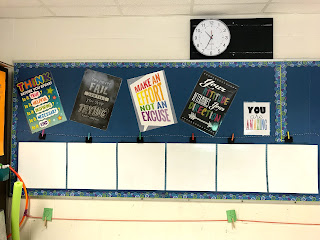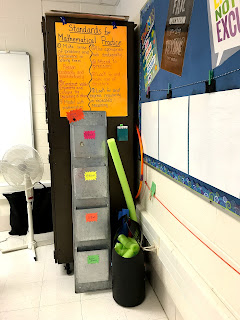Often times, when I chat with other math teachers, I ask what a typical class looks like. For years, I'd been curious about routines in classrooms that might benefit both myself and students. This past year marked ten year of teaching math and I
finally developed some routines that work well for me and the kiddos. Mind you, nothing is perfect and I'm always adjusting, but I thought I'd share what works for us in case something here might work for you. (5th grade)
Entering/Do Now: Students bring a math binder with them to class each day. (I'll talk more about the binder in another post.) On Monday's students go to the designated drawer to get a blank
Do Now sheet. I've edited it for the upcoming school year to put a greater focus on goal setting and include a graph.
Here's last year's version; the journaling didn't work well, so I replaced it. Each day, there is a Google Slide projected with the (required) objective, a daily Do Now, the plan for the day, and reminders about longer term assignments, such as the weekly homework. Students copy the objective down on to the form and complete the task for the day. They keep these sheets in their math binders until Friday, when they're collected and graded based on completion. Each day of the week has a specific type of task:
- Monday: Which One Doesn't Belong (WODB) Student must defend their choice.
- Tuesday: Reading graphs and a number talk
- Wednesday: MCAS Question (This is our state test. I opt for a review question a week instead of a boring and stressful review in the weeks leading up to it.)
- Thursday & Friday: Estimation 180
Students really enjoy WODB and Estimation 180, which is why I chose to begin and end the week with them. Both tasks allow students to enter where they're comfortable. Nearly all students eagerly participate in these activities. I sometimes feel guilty that I've tricked them into passionately engaging in math discussion and justifying their answers. But really, I'm quite tickled.
Lesson/Practice: This is where things look different day to day. If we're exploring something new, they'll be an introductory discussion where we all ask questions and investigate a bit. Admittedly, this always takes longer than I'd like. I'm working towards more student-led investigation and hands on activities that would sort of flow into the practicing bit. I try to have our as many writing-free discussions on our rug to build in some movement, change the location for a bit, and create a more relaxed environment to encourage participation. For practice, I typically select problems from varied resources, although often it is the workbook connected to our text. When we do this, I require certain problems of all students. They must come check in with me at a work table. If it's correct, students move on and usually earn flexible seating. Initially, students can come up three times before I invite them to my table for some help or pair them with a peer who overcame a similar struggle. I keep a roster at the table and keep track of who I've seen and whether or not they're ready to move on or need more help. In this time, I also try to run small targeting groups based on the prior week's wrap ups and quizzes.
Some days, we practice on white boards. Last year, I had small enough classes that there was enough space for all students to come up to board. Sometimes, I call out or project a problem and students turn and face me when they think they've got it. Sometimes, they simply work out specific printed problems at their own pace. It's neat to see them help their neighbors, but you do have to have a keen eye for those that are confused and are just copying the work of others. This is where it's important to chat with the kiddos to be sure they're understanding what they're doing.
Other days, we rotate through activities or task cards. Sometimes, we rotate through games. This part of our lesson is really dependent on where students are in their understanding and a number of other factors.
Wrap Up: Similar to the Do Now sheets, students grab the weekly Wrap Up sheet from the drawer on Mondays. These are specific to the week with one carefully constructed or selected problem for each day. Students often don't have enough time to do a good job with these in class, but they should at least take a peek before they leave. The sheet has a problem for each day Monday through Thursday. If they don't have time in class, students can work on them at home or if their Do Now is done the following morning. No matter how they choose to approach this, it is due on Friday and it is graded for correctness. The score is out of 4 points, one for each day, so it behooves students to make sure they're doing a good job. The problems selected are very closely tied to a weekly quick quiz and are the best resource for studying (although many students don't see the connection despite repeated explicit reminders). Student can ask for help on these either at the beginning of class or during extra help hours. Students who like to get ahead often try to do all of the problems on one day and get frustrated when they don't yet have the experience, understanding, and/or skills to do Thursday's problem because they haven't had the lesson!
Weekly Quiz: Students take a 5-10 question quiz on Fridays that have a range of questions requiring work and explanation as well correct vocabulary application. Last year, I thought I was being clever by calling them "Friday Flaunts." The intent was to reduce the anxiety over a quiz. The result was students not knowing what "flaunt" means and not reviewing the weekly lessons as I'd hoped. This year, they're just going to be called quizzes and we shall see what happens.
Grades: My grades are based off of homework, classwork, and assessments. Assessments include weekly quizzes, one test per unit (there's always a practice test), and at least two projects a quarter. All carry the same weight within the grade category. The projects are quite variable and designed with those who struggle with test taking in mind. Classwork always includes the Do Now and Wrap Up pages. It also includes some practice pages (although they're rarely graded), 3 act tasks, etc.
Homework: Last year, I purchased a year long homework packet from Teacher's Pay Teachers (my love/hate relationship here is a discussion for another time). Everyone loved the weekly set up, but the review nature of it was confusing for some students and families. This year, I'm attempting to write my own weekly homework sheet that's better aligned with current content. Students will be given the homework on Fridays. It's also posted on Google Classroom. The homework is broken down by day, Monday through Thursday. It includes current content as well as review. Students must hand it in at the beginning of class on Friday. Other than that, they can do any amount of problems on any day they choose as long as it's in on Friday and work is shown. I hold a designated extra help on Wednesdays before school specifically for homework. This allows students to take a look, give it a try, get some guidance, and try again before the week is over. Wrap Ups become homework if they're not done in class. Here's what I'm thinking it'll look like:
Homework due 9/21.
While it's a lengthy post, I feel like this just barely scratches the surface. It has been very helpful to have a scaffold for each day so that students know what to expect, within reason. There are other, more in depth considerations I haven't mentioned here, such as seating, but this gives a pretty good overview of the general structure of my class.
What things do you do that work for you? If you had to choose one aspect of your teaching that you'd suggest a colleague try, what would it be?















